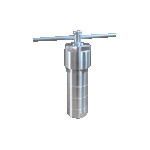|
1.Check
the instrument carefully before use. Check whether the glass bottle is
damaged and whether the interfaces are consistent. Be careful to
handle it gently.
2. Wipe each interface with a
piece of soft cloth (can be replaced by a napkin), and then apply a little vacuum
grease. (The
applied vacuum grease must be covered to prevent dust and
sand from entering.)
3. Each interface should not be
tightened excessively, and should be loosened regularly to avoid causing
long-term locking and the connector capture.
4. Turn on the power switch first,
and then let the machine run from slow to fast. When shutting down,
keep the machine in a stopped state, and then turn off the switch.
5. PTFE switches at
all positions can't
be tightened with excessive force, and
they are prone to damage the glass.
6. After each use, you must use a
piece of soft cloth to wipe off all kinds of oil stains, stains, and solvent
remaining on the surface of the machine to keep it clean.
7. Loosen the PTFE switches after
the machine stops, and the PTFE piston will be deformed if it is in
the working state for a long time.
8. Clean the sealing ring regularly according to the steps of removing the sealing ring, checking whether there is dirt on the
shaft, wiping it with a soft cloth, then applying a little vacuum
grease and reinstalling it to keep the shaft and the sealing ring
smooth.
9. The electrical parts must not be
exposed to water, and it is strictly forbidden to get wet.
10. When doing any repairs or
inspections on the machine, be sure to disconnect the power and water
source first.
|




.jpg)





